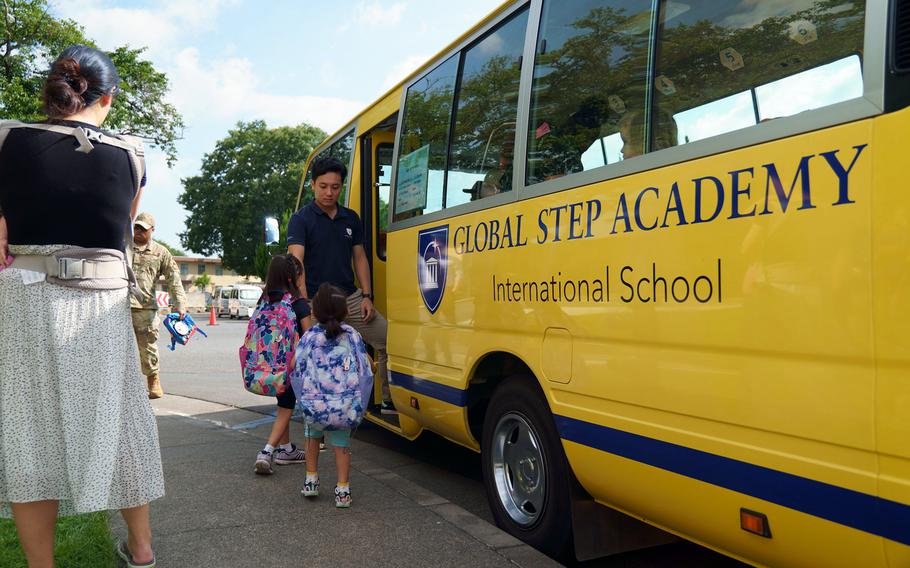
A bus driver greets students heading for Global Step Academy, an international school popular with the community at Yokota Air Base, Japan, July 20, 2023. (Akifumi Ishikawa/Stars and Stripes)
YOKOTA AIR BASE, Japan — Military parents who send their children to Global Step Academy, a pre-school and kindergarten for international students, said they’re relieved that Japan now requires an alert system onboard some school buses.
The device is required by the government and uses a 4D imaging radar that picks up movement, even a child crying in the vehicle, up to 15 minutes after the engine is shut off, according to Japan’s Cabinet Office.
The motion sensor works in tandem with an alarm to alert the operator to check the bus. The device also pings registered phone numbers if motion is detected.
Global Step installed devices on its two buses on July 10, and has its own verification methods, principal Yasuko Toshida said at the school in Tachikawa on July 20. More than 30 children ride the academy’s buses to and from Yokota every weekday.
“Extra safety is always good, so yes, we are happy,” she said.
The international school is among several that provide services outside of Yokota for military families.
“It makes me feel a little better,” Air Force spouse Lindsey Zgoda said July 20 at the airlift hub in western Tokyo. She has two children, ages 3 and 5, attending the school. “We haven’t had any issues at all, the staff has been great, and I haven’t ever been concerned about the kids being left on the bus.”
The deaths of several children left behind on school buses in Japan prompted the government in April to require child-detection devices on buses for nurseries, pre-school and kindergarten by March 2024.
In September in Shizuoka prefecture, a 3-year-old girl died after being trapped inside an unattended school bus for five hours on a hot day. In July 2021, a boy, 5, died in Fukuoka prefecture after being trapped nine hours, according to the newspaper, Asahi Shimbun.
Masanobu Ogura, the Japanese minister in charge of child policies, urged child-care facilities in June to install safety systems on their buses ahead of the March deadline. The government encouraged their installation this summer, ahead of the onset of higher temperatures and chances of heat stroke.
Schools on U.S. military bases in Japan that transport students on and off base are not required to install the device, according to Miranda Ferguson, spokeswoman for Department of Defense Education Activity-Pacific.
However, DODEA requires its drivers to walk the aisles and confirm buses are empty, then place an “Empty Bus” sign at the back, she said by email Wednesday.
About half of the 50,000-plus buses required by Japan to have the safety devices are in compliance or making progress, according to Ogura. Institutions that fail to meet the deadline face penalties, including a business suspension.
Each institution must also maintain a checklist to prevent mishaps, according to the government policy. Bus drivers are responsible for attendance procedures to ensure children are safe on and off the bus.
“I felt great to know that steps are being taken to protect the kids,” Air Force spouse Eduardo Gomez-Urdampilleta, whose two children, ages 5 and 3, attend Global Step Academy, said July 20.
Stars and Stripes reporters Akifumi Ishikawa and Hana Kusumoto contributed to this report.